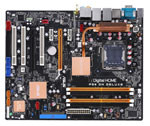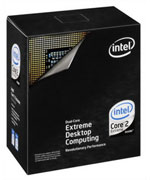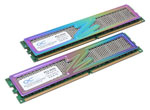Intel Ultra High-End Platform
Finally, we come to the granddaddy of all high-end computer configurations. Oh sure, we could go off the deep end and recommend a dual socket motherboard with Xeon 5160 processors and multiple gigabytes of memory - or you could go out and purchase one of the new Mac systems and get the same thing (minus CrossFire/SLI support) - but outside of workstation class applications a fast single socket configuration will usually offer better performance, and it will save you quite a bit of money.
 |
The MSI motherboard in our basic Intel recommendation is still a good motherboard, and the Abit AW9D and AW9D-Max are another alternative. However, if you want what is considered the best overall 975X motherboard right now, that distinction continues to belong to the ASUS P5W DH Deluxe. Capable of reaching bus speeds of over 400MHz while maintaining stability, and offering full support for 2x8 CrossFire, the ASUS P5W DH has all the features necessary for building an ultimate performance computer. It also fully supports the upcoming Core 2 Extreme QX6700 for those that are planning to upgrade to quad cores in the future. Prices have also come down quite a bit since the initial Core 2 launch, although at $230 the P5W DH certainly isn't an inexpensive motherboard. Thankfully, as the saying goes, you get what you pay for, and what you're paying for here is optimum performance.
 |
When it comes to CPU performance, the Core 2 Extreme X6800 is currently the fastest mainstream processor available. In our initial review, we found that the X6800 didn't lose a single benchmark to any other processor. Similar to AMD's FX series, Core 2 Extreme also comes with unlocked CPU multipliers, so you also gain the benefit of being able to overclock via higher multipliers rather than simply increasing bus speed. (That could prove especially useful if you want to get an nForce4 SLI for Intel motherboard.) If you're interested in achieving maximum performance at any price, you will certainly want the X6800. Just don't get too upset when something faster comes out in the not-too-distant future.
 |
For our ultra high-end configuration, we have pulled out all the stops and gone with some of the fastest memory we have ever tested. The OCZ Titanium VX2 is rated at DDR2-1000, and it is also certified for operation with up to 2.4V. Depending on personal preference, you might also find the chromatic heatsinks to be the best thing ever... or not. In our performance testing, the OCZ VX2 was able to keep up with the best memories currently available. Beyond DDR2-1100, increased latencies often reduce performance making higher clock speeds less useful, but up through DDR2-1067 there are actual performance benefits to be had. Are the benefits worth the extra $150? For a lot of people, the answer is no, but anyone seriously considering a $1000 processor is probably going to want maximum performance in all other areas as well.

 |
Going along with the maximum performance trend, our graphics card selection consists of the recently launched ATI X1950 series, with the obligatory XTX + CrossFire combination. Sporting the same GPU clock speed as the X1900 XTX but utilizing GDDR4-2000 rather than GDDR3-1550, the X1950 is the fastest single GPU currently available. (The GeForce 7950 GX2 is still faster in some situations, but that is technically two GPU cores, and as already mentioned the prospects of upgrading to quad SLI are not without their drawbacks.) ATI's latest driver updates have also further improved performance of all of the R580 cards, with the net result being that X1950 CrossFire is faster than the NVIDIA alternative in most games.
Lastly, we come to the storage subsystem. Anyone looking for even more extreme performance could always add a couple of 150GB Western Digital Raptor drives in RAID 0, but for an ultra high-end computer we prefer more storage over slightly faster hard drives. Thus, we have chosen two 500GB Western Digital hard drives, which you can once again choose to run in RAID 0, RAID 1, or simply as individual drives, giving you up to a full terabyte of storage. You could further upgrade to RAID 1+0 for performance and redundancy, although that would also require four hard drives which is more than most people want to install in a home computer. We certainly aren't recommending this configuration as the best choice for every single person: get what you feel is most beneficial for your storage needs.















45 Comments
View All Comments
Zebo - Tuesday, October 10, 2006 - link
Anandtech really needs to start doing monitor tests again. I don't know if you used those Acers but they suck bad. And the Dell 24" suffers from serious input lag and poor view angles like the TN Acers. LCD's are not a commodity where you can graph price/size and pick your winner. Does 8 bit means nothing? Color shift? Input lag? Lying specs vs. real specs? Good viewing angles? LCD scaling for gamers?The 30" Dell is pretty decent as it's an IPS but not overdriven like the new HP so it's slow.
JarredWalton - Tuesday, October 10, 2006 - link
I've got both Dells, and they work fine for everything I do. Overdriving displays is mostly just playing the numbers game. If you can see pixel lag on any of the Dell LCDs mentioned, then you can probably see pixel lag on virtually every LCD on the market. I will be doing some LCD reviews in the near future, but so far I have far bigger issues with prices than I do with performance. I just wish I could get an LCD that ran at a high refresh rate in order to avoid tearing when vsync is disabled. Unless you do professional imaging work where having accurate color values is absolutely necessary, most LCDs will get the job done. As for the Acer displays, they did get put on the bottom of the pricing chart for a reason, and I don't think they are the highest quality displays available. They aren't the worst displays available, and without spending twice as much money it is unlikely that he will seek dramatically better performance or colors in the same size display.limiter - Tuesday, October 10, 2006 - link
I agree on the price, I bought a cheap (under $275), BenQ FP202W 20.1in Widescreen display that got panned by Tom's Hardware as the worst 20.1in widescreen monitor they've ever seen, yet I think it's great. I don't see lag, or the other problems mentioned in their review. I went from a 19in CRT so it's not like I was going from a 15in at 32ms to 8ms and that's why I think it's great. Maybe I just have bad eyes, but I'd buy it again.JarredWalton - Tuesday, October 10, 2006 - link
That's a perfect case in point. While it is definitely possible to measure differences between LCDs, the simple truth is that most people can't tell the difference without specialized hardware to measure values. For example, a display that has colors that are off by 10% might not look as good next to a display that has accurate colors. However, if you're viewing them individually in separate rooms, you're going to have a difficult time determining which is better using just your eyes. The lighting in a room often has more of an impact on the display visuals for typical users than the display itself.Howard - Monday, October 9, 2006 - link
The efficiency of a PSU has nothing to do with its actual power output.JarredWalton - Monday, October 9, 2006 - link
No, and I don't believe I said it does. It has to do with how much power is used internally in the conversion process, so a 70% efficient 600W PSU could in theory draw 857W and an 85% efficient 600W PSU would only draw 706W - something like that.I guess the text implied that the efficiency meant it could output 500W. What I meant is that it can do 500W output, and it can do it at a high efficiency. There are plenty of "500W" PSUs out there that would fail if you really tried to pull 500W from them. I'll clear up the text....
yyrkoon - Tuesday, October 10, 2006 - link
Actually, I believe its more like power thats NOT lost to heat while being converted to DC, from AC. Feel free to correct me if Im wrong though :)BigLan - Monday, October 9, 2006 - link
Given the ati-amd merger, the AMD god box uses nvidia sli while the Intel box uses ATi crossfire. I suspect that in a year that situation will be reversed.Good guide btw, it's nice to dream about building a system like this, but I'd stick with my Scythe Ninja for a HSF.
limiter - Monday, October 9, 2006 - link
How much of this hardware did you guys test together? I wonder especially about the memory and the optical drives simply because there seem to be a number of modules and drives out there that either don't work, or don't work as well as they should with the p965/975x motherboards. I'm looking at building a new system soon and really appreciate these guides, but I would like to see either confirmation that at least the memory was tested with the motherboard/processor combo listed, or that someone else has tested it and you are going off that... I guess just for peace of mind before buying anything. The motherboard manufacturers list a small number of compatible modules, ASUS being the worst.Gary Key - Monday, October 9, 2006 - link
The majority of the components have all been tested on a large cross-section of boards. Some components work better in certain boards (even though the chipsets are the same) than others. Memory was a very weak area in the P965 launch and it was not the budget memory at the time, it was the upper end memory that was having issues. My opinion on the subject matter is that both the memory and motherboard suppliers had equal issues. The majority of it has cleared up now although it is difficult to understand why certain memory modules and bios updates still have issues playing nice with each other. As far as optical drives, please let us know which one is having an issue, tried over 18 different optical drives from a Kenwood TrueX to a Pioneer Blu-ray without an issue on our current collection of 965/975 boards. At least 11 different hard drives have been used also at this time.